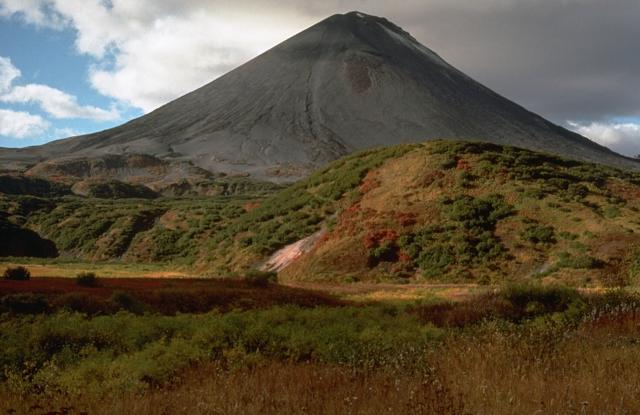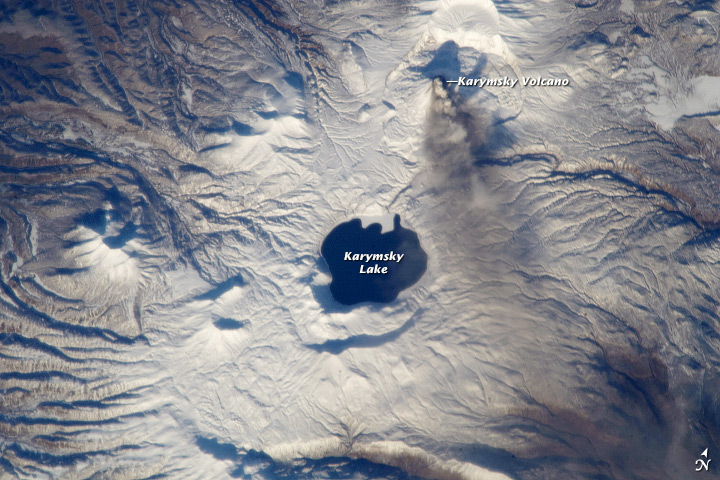|
Akademia Nauk
Akademia Nauk (russian: Академия Наук - ''Academy of Sciences'') is a volcano located in the southern part of Kamchatka Peninsula, Russia. The volcano is filled with a few calderas, and the most notable one is known as Karymsky Lake ( named after Karyms). The volcano is named after the ''Росси́йская Акаде́мия Нау́к'', the Russian (Soviet) Academy of Sciences. It last erupted in January 1996. See also *List of volcanoes in Russia This is a list of active and extinct volcanoes in Russia. European Russia Kamchatka Volcanoes of the Kamchatka Peninsula of the northwestern Pacific Ocean and the Russian Far East. Kuril Islands Volcanoes of the Kuril Islands, in the nor ... References Active volcanoes Volcanoes of the Kamchatka Peninsula Mountains of the Kamchatka Peninsula Calderas of Russia Pleistocene volcanoes Holocene Asia VEI-7 volcanoes {{KamchatkaKrai-geo-stub ... [...More Info...] [...Related Items...] OR: [Wikipedia] [Google] [Baidu] |
Karymsky (volcano)
Karymsky (russian: Карымская сопка, ''Karymskaya sopka'') is an active stratovolcano on the Kamchatka Peninsula, Russia. It is currently the most active volcano on the Kamchatka Peninsula, as well as the most active volcano of Kamchatka's eastern volcanic zone. It is named after the Karyms, an ethnic group in Russia. Description Karymsky is a symmetrical stratovolcano rising within a 5-km-wide caldera that formed during the early Holocene. Much of the cone is mantled by lava flows less than 200 years old. Historical eruptions have been vulcanian or vulcanian- strombolian with moderate explosive activity and occasional lava flows from the summit crater. There is currently an ongoing cycle of non-stop eruption occurring, and is the peninsula's most active, and reliable volcano, which has been erupting continuously since 1996. Eruptions An ongoing cycle of almost continuous eruption has been occurring since 1996. See also * List of volcanoes in Russia * ... [...More Info...] [...Related Items...] OR: [Wikipedia] [Google] [Baidu] |
Karyms
Karyms (russian: Карымы) is an ethnic group in Russia which are métises of mixing Russians with Evenks and Buryats resulting from the lack of women among Russia Russia (, , ), or the Russian Federation, is a List of transcontinental countries, transcontinental country spanning Eastern Europe and North Asia, Northern Asia. It is the List of countries and dependencies by area, largest country in the ...n settlers. In the 2002 Russian Census, 2 persons self-identified themselves as Karyms [...More Info...] [...Related Items...] OR: [Wikipedia] [Google] [Baidu] |
Pleistocene Volcanoes
The Pleistocene ( , often referred to as the ''Ice age'') is the geological epoch that lasted from about 2,580,000 to 11,700 years ago, spanning the Earth's most recent period of repeated glaciations. Before a change was finally confirmed in 2009 by the International Union of Geological Sciences, the cutoff of the Pleistocene and the preceding Pliocene was regarded as being 1.806 million years Before Present (BP). Publications from earlier years may use either definition of the period. The end of the Pleistocene corresponds with the end of the last glacial period and also with the end of the Paleolithic age used in archaeology. The name is a combination of Ancient Greek grc, label=none, πλεῖστος, pleīstos, most and grc, label=none, καινός, kainós (latinized as ), 'new'. At the end of the preceding Pliocene, the previously isolated North and South American continents were joined by the Isthmus of Panama, causing a faunal interchange between the two reg ... [...More Info...] [...Related Items...] OR: [Wikipedia] [Google] [Baidu] |
Calderas Of Russia
A caldera ( ) is a large cauldron-like hollow that forms shortly after the emptying of a magma chamber in a volcano eruption. When large volumes of magma are erupted over a short time, structural support for the rock above the magma chamber is gone. The ground surface then collapses into the emptied or partially emptied magma chamber, leaving a large depression at the surface (from one to dozens of kilometers in diameter). Although sometimes described as a crater, the feature is actually a type of sinkhole, as it is formed through subsidence and collapse rather than an explosion or impact. Compared to the thousands of volcanic eruptions that occur each century, the formation of a caldera is a rare event, occurring only a few times per century. Only seven caldera-forming collapses are known to have occurred between 1911 and 2016. More recently, a caldera collapse occurred at Kīlauea, Hawaii in 2018. Etymology The term ''caldera'' comes from Spanish ', and Latin ', meaning "co ... [...More Info...] [...Related Items...] OR: [Wikipedia] [Google] [Baidu] |
Mountains Of The Kamchatka Peninsula
A mountain is an elevated portion of the Earth's crust, generally with steep sides that show significant exposed bedrock. Although definitions vary, a mountain may differ from a plateau in having a limited summit area, and is usually higher than a hill, typically rising at least 300 metres (1,000 feet) above the surrounding land. A few mountains are isolated summits, but most occur in mountain ranges. Mountains are formed through tectonic forces, erosion, or volcanism, which act on time scales of up to tens of millions of years. Once mountain building ceases, mountains are slowly leveled through the action of weathering, through slumping and other forms of mass wasting, as well as through erosion by rivers and glaciers. High elevations on mountains produce colder climates than at sea level at similar latitude. These colder climates strongly affect the ecosystems of mountains: different elevations have different plants and animals. Because of the less hospitable terrain and ... [...More Info...] [...Related Items...] OR: [Wikipedia] [Google] [Baidu] |
Volcanoes Of The Kamchatka Peninsula
A volcano is a rupture in the crust of a planetary-mass object, such as Earth, that allows hot lava, volcanic ash, and gases to escape from a magma chamber below the surface. On Earth, volcanoes are most often found where tectonic plates are diverging or converging, and most are found underwater. For example, a mid-ocean ridge, such as the Mid-Atlantic Ridge, has volcanoes caused by divergent tectonic plates whereas the Pacific Ring of Fire has volcanoes caused by convergent tectonic plates. Volcanoes can also form where there is stretching and thinning of the crust's plates, such as in the East African Rift and the Wells Gray-Clearwater volcanic field and Rio Grande rift in North America. Volcanism away from plate boundaries has been postulated to arise from upwelling diapirs from the core–mantle boundary, deep in the Earth. This results in hotspot volcanism, of which the Hawaiian hotspot is an example. Volcanoes are usually not created where two tectonic plates slide pa ... [...More Info...] [...Related Items...] OR: [Wikipedia] [Google] [Baidu] |
Active Volcanoes
An active volcano is a volcano which is either erupting or is likely to erupt in the future. An active volcano which is not currently erupting is known as a dormant volcano. Overview Tlocene Epoch. Most volcanoes are situated on the Pacific Ring of Fire. An estimated 500 million people live near active volcanoes. ''Historical time'' (or recorded history) is another timeframe for ''active''. However, the span of recorded history differs from region to region. In China and the Mediterranean, it reaches back nearly 3,000 years, but in the Pacific Northwest of the United States and Canada, it reaches back less than 300 years, and in Hawaii and New Zealand it is only around 200 years. The incomplete ''Catalogue of the Active Volcanoes of the World'', published in parts between 1951 and 1975 by the International Association of Volcanology, uses this definition, by which there are more than 500 active volcanoes. , the Smithsonian Global Volcanism Program recognizes 560 volcanoes with ... [...More Info...] [...Related Items...] OR: [Wikipedia] [Google] [Baidu] |
List Of Volcanoes In Russia ...
This is a list of active and extinct volcanoes in Russia. European Russia Kamchatka Volcanoes of the Kamchatka Peninsula of the northwestern Pacific Ocean and the Russian Far East. Kuril Islands Volcanoes of the Kuril Islands, in the northwestern Pacific Ocean between the Kamchatka Peninsula and Japan. Other parts of Russia Example References {{Russia topics Russia Lists of coordinates Volcanoes Volcanoes A volcano is a rupture in the crust of a planetary-mass object, such as Earth, that allows hot lava, volcanic ash, and gases to escape from a magma chamber below the surface. On Earth, volcanoes are most often found where tectonic plates a ... [...More Info...] [...Related Items...] OR: [Wikipedia] [Google] [Baidu] |
Russian Academy Of Sciences
The Russian Academy of Sciences (RAS; russian: Росси́йская акаде́мия нау́к (РАН) ''Rossíyskaya akadémiya naúk'') consists of the national academy of Russia; a network of scientific research institutes from across the Russian Federation; and additional scientific and social units such as libraries, publishing units, and hospitals. Peter the Great established the Academy (then the St. Petersburg Academy of Sciences) in 1724 with guidance from Gottfried Leibniz. From its establishment, the Academy benefitted from a slate of foreign scholars as professors; the Academy then gained its first clear set of goals from the 1747 Charter. The Academy functioned as a university and research center throughout the mid-18th century until the university was dissolved, leaving research as the main pillar of the institution. The rest of the 18th century continuing on through the 19th century consisted of many published academic works from Academy scholars and a few Ac ... [...More Info...] [...Related Items...] OR: [Wikipedia] [Google] [Baidu] |
Karymsky Lake
Karymsky Lake (russian: Карымское озеро) is a volcanic crater lake located in the Akademia Nauk volcano on the Kamchatka Peninsula The Kamchatka Peninsula (russian: полуостров Камчатка, Poluostrov Kamchatka, ) is a peninsula in the Russian Far East, with an area of about . The Pacific Ocean and the Sea of Okhotsk make up the peninsula's eastern and w ..., Russia. References Lakes of Kamchatka Krai Volcanic crater lakes Volcanoes of the Kamchatka Peninsula Calderas of Russia Pleistocene calderas {{KamchatkaKrai-geo-stub ... [...More Info...] [...Related Items...] OR: [Wikipedia] [Google] [Baidu] |
Kamchatka Krai
Kamchatka Krai ( rus, Камча́тский край, r=Kamchatsky kray, p=kɐmˈtɕatskʲɪj kraj) is a federal subject of Russia (a krai), situated in the Russian Far East, and is administratively part of the Far Eastern Federal District. Its capital and largest city is Petropavlovsk-Kamchatsky, home to over half of its population of 322,079 ( 2010). Kamchatka Krai was formed on July 1, 2007, as a result of the merger of Kamchatka Oblast and Koryak Autonomous Okrug, based on the voting in a referendum on the issue on October 23, 2005. The okrug retains the status of a special administrative division of the krai, under the name of Koryak Okrug. The Kamchatka Peninsula forms the majority of the krai's territory, separating the Sea of Okhotsk and the Bering Sea in the Pacific Ocean. The remainder is formed by a minor northern mainland portion, Karaginsky Island, and the Commander Islands in the Bering Sea. It is bordered by Magadan Oblast to the west and Chuk ... [...More Info...] [...Related Items...] OR: [Wikipedia] [Google] [Baidu] |
Caldera
A caldera ( ) is a large cauldron-like hollow that forms shortly after the emptying of a magma chamber in a volcano eruption. When large volumes of magma are erupted over a short time, structural support for the rock above the magma chamber is gone. The ground surface then collapses into the emptied or partially emptied magma chamber, leaving a large depression at the surface (from one to dozens of kilometers in diameter). Although sometimes described as a Volcanic crater, crater, the feature is actually a type of sinkhole, as it is formed through subsidence and collapse rather than an explosion or impact. Compared to the thousands of volcanic eruptions that occur each century, the formation of a caldera is a rare event, occurring only a few times per century. Only seven caldera-forming collapses are known to have occurred between 1911 and 2016. More recently, a caldera collapse occurred at Kīlauea, Hawaii in 2018. Etymology The term ''caldera'' comes from Spanish language, S ... [...More Info...] [...Related Items...] OR: [Wikipedia] [Google] [Baidu] |








